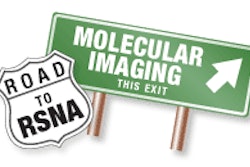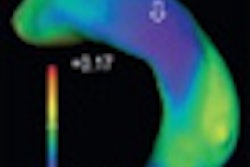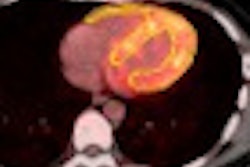Molecular breast imaging (MBI) finds three times as many cancers as conventional mammography in women with dense breasts, according to a new study published online in Radiology. This is welcome news, because while mammography continues to be the gold standard for breast cancer screening, its sensitivity has been shown to be reduced in this population.
Researchers at the Mayo Clinic in Rochester, MN, compared the performance of MBI with a dual-head dedicated breast gamma camera to that of mammography in screening women with dense breast tissue. They found that adding MBI to mammography increased detection of node-negative breast cancer in dense breasts by 7.5 per 1,000 women screened (Radiology, November 2, 2010).
"We've been working on this study for a long time," lead author Deborah Rhodes, MD, told AuntMinnie.com. "We never intended to suggest that molecular breast imaging should replace mammography as an annual screening exam, but we did want to investigate whether it could be of use in the screening setting in this particular population of women."
Rhodes and colleagues examined data between September 2005 and February 2009 from 936 women who underwent regular mammography and also gamma imaging after a 20-mCi injection of technetium-99m sestamibi. Eight-six percent, or 802, of these women had dense breast tissue.
For the study, the team acquired at least two views with gamma imaging, using one of two dual-head gamma cameras mounted on a modified mammographic gantry; each of the devices utilized two 20 x 20-cm cadmium zinc telluride (CZT)-based detectors (Prototype CZT, GE Healthcare, Chalfont St. Giles, U.K.; LumaGem, Gamma Medica, Northridge, CA). Mammography exams were acquired with either a film-screen device (Lorad M-IV, Hologic, Bedford, MA) or a digital unit (Selenia, also Hologic).
Study participants had the MBI scans performed within three weeks of their mammography exam. Final cancer status was verified by a subsequent annual mammogram, surgical excision, or core-needle biopsy results.
In the 936 study participants, 11 cancers were found: One was detected with mammography only, seven with MBI only, and two with both of the modalities combined. One cancer was not detected by either technology. Of the cancers found by MBI only, six were invasive and all were node-negative, according to Rhodes.
Diagnostic yield was 3.2 cancers per 1,000 with mammography, 9.6 cancers per 1,000 with MBI, and 10.7 cancers per 1,000 for both; the sensitivity of mammography was 27% (three cancers of 11) and the sensitivity of MBI was 82% (nine of 11).
The study findings are exciting in that molecular breast imaging can help find more cancers, Rhodes said. But even more exciting is that the team has determined how to reduce radiation dose -- from the 20-mCi dose used at the beginning of the study to 4 mCi -- and the group continues to gather clinical data using this lower dose.
"We've worked on enhancements to the detectors, the collimators, the software used to analyze the images -- all so that each component could be optimized and we can get the absolute most powerful performance out of the technology," Rhodes said. "We continue to find mammographically occult cancers at the same rate using the 4- mCi dose as we were finding with the 20-mCi dose."
But the findings do not mean that MBI should replace mammography as the screening standard, according to Rhodes. Screening for breast cancer should be tailored to individual women, however.
"From my vantage point, mammographers are heroes," Rhodes said. "Day after day they read a difficult exam in a very litigious medical environment. And mammography works profoundly well as a breast cancer screening tool for the vast majority of women. But there is a subset of women it doesn't serve as well: those with dense breasts. If we can figure out a way to supplement mammography, at low cost and with minimal excess radiation, we'll have a much more effective screening protocol overall."
Rhodes did not report any conflicts of interest in the study. Some of the co-authors on the study reported that they have licensed rights to MBI technology to Gamma Medica, and that Gamma Medica and the Mayo Clinic have a licensing agreement for technology developed at Mayo. One co-author reported receiving funding from GE for a new radiopharmaceutical for breast imaging.
By Kate Madden Yee
AuntMinnie.com staff writer
November 16, 2010
Related Reading
MBI casts wider net for improved breast cancer diagnosis, September 14, 2010
MBI could help breast centers caught in economic squeeze, September 14, 2010
New imaging tools address challenges of dense breast tissue, September 14, 2010
Radiation dose in women's imaging: Are we scared yet? September 14, 2010
Nuclear breast imaging may have greater cancer risks, August 24, 2010
Copyright © 2010 AuntMinnie.com



















